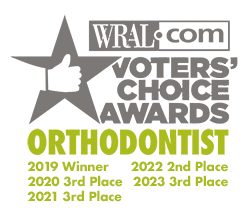Jaw expansion, also known as maxilla or palatal expansion, is a common orthodontic treatment for widening the upper jaw, increasingly utilized over the last five decades in the United States to avoid tooth extraction. Today, palate expanders are frequently used in children as young as 6 years old, driven by factors such as the popularity of Teen Invisalign, self-ligating braces, and concerns about obstructive sleep apnea. Parents often grapple with the decision of whether their child truly needs an expander and at what age it’s appropriate.
What is a palatal expander?
A palatal expander is a device, typically made of metal or a combination of metal and acrylic, that is placed on the roof of the mouth and anchored to the back teeth. A small key is inserted in the hole in the middle of the device and turned once or twice per day to push the two halves of the upper jaw apart. With each turn, the upper jaw becomes wider. In children, the process is painless, and the patient only feels pressure across the upper jaw.
Palatal expanders are fixed to the roof of the mouth. Removable expansion devices can be taken out to eat and clean but are less effective at widening the upper jaw. Additionally, removable expansion devices can be less stable as they may cause more outward tipping of the teeth which can result in a quick relapse of the expansion you have been working to create.
How does palatal expansion work?
The upper jaw consists of two bones separated by a joint at the midline, called the mid-palatal suture. This joint stays open until approximately 12 years of age, then gradually begins to fuse. If pressure is applied across the mid-palatal suture before the suture has closed, the two halves of the palate will move apart, permanently widening the upper jaw. If pressure is applied after the mid-palatal suture is closed, the teeth will be tipped outward, which may or may not be a desired tooth movement.
How long do expanders stay in place?
The active expansion phase for fixed expanders is typically 3-6 weeks, depending on how much additional width is needed. Once the amount of expansion is achieved, the expander is left in place for approximately three months to allow new bone to grow in the site where the two bones were pushed apart, maintaining the new width of the upper jaw.
At what age should a child get a palate expander?
Early intervention definitely makes it easier to reshape the upper jaw and prevent more significant orthodontic problems down the road. The need for palatal expansion is best assessed after the upper permanent (adult) first molars come in and the upper permanent incisors are starting to emerge. This is typically after 7-8 years of age but can vary from patient to patient.
Some dentists will place expanders in children as early as 3 years of age, but delaying treatment until later may be a better idea to give the child time to grow and be more receptive to the intervention. If a crossbite is present at 3 years of age, it can be safely and effectively treated when the child is older than 7 or 8 years of age and before the mid-palatal suture has fused.
Jaw expansion may be possible after 12 years of age, but the older the patient, the more likely the upper jaw won’t expand and the upper teeth will be tipped outward. This means that the expansion won’t be stable. It’s important to remember that expanded teeth tend to tip back inward to their original location while expanded jaws tend to be stable.
Are Palatal Expanders Necessary for My Child?
An orthodontist can best determine whether a palate expander is an appropriate solution for jaw-related and tooth alignment problems such as:
Crowded or overlapped teeth
Expanding the upper jaw can often fix mild to moderate overcrowding without the need for tooth extraction. But for severe crowding, removing teeth to create adequate space may be necessary and may lead to healthier teeth and gums in the long run. Plus, some kids who have teeth removed for orthodontic treatment may not need their wisdom teeth removed later in life because enough space was created for them to grow in naturally.
Impacted or ectopically erupting teeth
A routine screening x-ray will show whether there are teeth that are not in their proper place or are growing in the wrong direction. Impacted or ectopic canines are one of the most common problems orthodontists treat. The upper permanent canines (the third tooth from the center on each side) have a tendency to grow in the wrong direction. If left untreated, these canines can get stuck in the roof of the mouth or damage the roots of the adjacent teeth. In approximately 80% of ectopic canines, a combination of upper jaw expansion and early removal of the upper baby canines will help the wayward canine find its way into its proper position.
Crossbites
When the upper jaw is more narrow than the lower jaw, the upper teeth will bite inside the lower teeth, opposite from what is normal. When a crossbite is present, the lower jaw often shifts to the side while biting down, causing the lower jaw to look crooked or asymmetric. Sometimes a shift of the lower jaw is not present, but the upper jaw appears narrow when the patient smiles. When the back teeth are in a crossbite, the teeth can wear down prematurely due to the incorrect fit of the teeth.
Breathing problems and snoring
Some dentists say expanding the upper jaw can help improve breathing, eliminate snoring, and treat pediatric sleep apnea (where the child stops breathing while asleep due to a blockage or narrowing of the airway.) However, scientific studies have repeatedly shown that jaw expansion does not open the airway enough to treat breathing problems, including sleep apnea. Beware of dental practices that advertise “airway-friendly” orthodontics. Any child with suspected breathing problems should be seen by a Pediatric E.N.T. (Ear/Nose/Throat) doctor to have their airway examined and treated if indicated.
But what about my child’s lower jaw?
The lower jaw cannot expand the same way as the upper jaw because the lower jaw consists of a single U-shaped bone. There is no joint at the midline. When expanders are placed on the lower teeth, the pressure simply pushes the teeth outward, which may only be necessary if the teeth are tipped inward, causing crowding of the lower teeth and a dental arch that appears too narrow. It is important to regulate the amount of lower teeth expansion, as excessive expansion may cause the supporting gum and bone around the teeth to recede.
Precautions for Dental Expanders
- Palatal expanders have become a one-size-fits-all solution over the years, with hundreds of thousands of children (and adults) undergoing expansion when a less invasive, less costly, and ultimately more stable procedure may have been more appropriate for them.
- Use of removable expanders may lead to more unstable tipping of the teeth than actual jaw expansion. If the upper jaw is narrow, fixed palatal expansion is indicated.
- Inappropriate expansion and over-expansion can lead to excessive protrusion of the front teeth (teeth that look like they stick out too much).
- Over-expansion to create space to align the teeth may ultimately lead to a lack of space for the last molars to grow in after 12 years of age. When the last molars cannot completely erupt, a flap of gum will remain over the back tooth, creating an area that is prone to an infection called pericoronitis.
- Expansion in older teens and adults (after the mid-palatal suture closes) can lead to the teeth being pushed out of the supporting bone. This “dental expansion” will frequently relapse – the teeth will move back to where they started soon after the treatment is complete.
- Unfortunately, it can be hard for parents to tell if their child would truly benefit from palatal expansion. It is essential for parents to be aware that some dental professionals may recommend an expander for financial gain, even when it is unnecessary.
Before agreeing to any unnecessary dental work, such as a palate expander to prevent tooth extraction or sleep apnea, it is recommended to seek a second opinion. As Dr. Neal D. Kravitz, DMD, MS, Harvard graduate, and Editor-in-Chief for the Journal of Clinical Orthodontics, pointed out, some dentists have regressed to “pseudoscience” and are “pushing non-extraction methods and practicing outside the boundaries of evidence-based treatment.” Only a certified orthodontist should prescribe palate expanders for your child.
At Walton and Maready, we prioritize transparency and will never recommend appliances or treatments unless they are essential for your child’s current and future oral health. If a dental professional has prescribed an expander for your child and you would like a second opinion, please contact us for a free consultation. Your child’s joy and well-being take top-priority at our practice.








